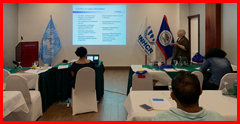On Saturday, November 2, 2019, journalists and other media personnel met at the Best Western Biltmore Plaza for a one-day training on asylum seekers and refugees. While in Belize we are not posed with droves of asylum seekers and refugees, there are instances where we do see an influx of those people. They usually hail from Central American countries including Guatemala, Honduras, and El Salvador and it is with a focus on those persons that the United Nations High Commission for Refugees (UNHCR) facilitated the session. UNHCR, the UN Refugee Agency in Belize, has been working alongside the Government of Belize (GOB) through its relevant ministries and departments. Those include the Refugees Department and the Refugee Eligibility Committee (REC).
The training focused on those refugees, their contributions, and both the international and regional context and legality regarding asylum seekers and refugees. Janice Marshall, Senior Consultant of the UN Refugee Agency in Belize, guided those conversations. She began by referencing international refugee law which gives the definition of a refugee as given by the Universal Declaration of Human Rights (UNHR). According to that declaration, a refugee is someone who has been forced to flee his or her country because of persecution, war, or violence. A refugee has a well-founded fear of persecution for reasons of race, religion, nationality, political opinion, or membership in a particular social group. Most likely, they cannot return home or are afraid to do so. War and ethnic, tribal and religious violence are leading causes of refugees fleeing their countries. A refugee is unable or unwilling to avail him/herself of the protection of his/her country. In the declaration’s 14th article, a refugee is given the right to seek and enjoy asylum for persecution in other countries. The declaration, however, is not legally binding but has been signed on to by hundreds of countries worldwide. Besides enjoying the right to seek and enjoy asylum, a refuges is also not to be returned to danger. In other words, a refugee should not be returned to his or her country if the threat to their life is not eradicated or diffused. Alongside the declaration, there is a Convention relating to the status of refugees developed in 1951 and put in force in 1954 and a Protocol relating to the status of a refuges adopted and put in force in 1967.
Internationally, there are around 41.8 million displaced persons, 25.9 million refugees, and 3.5 million asylum seekers. As a global community, we are at the highest level of displacement, considering the 2018 statistics. Of those numbers, most people, around 67%, are from Syria, Afghanistan, South Sudan, Myanmar, and Somalia. Often times, these persons are facing imminent danger due to political reasons and are more often than not running from wars, genocides, persecution, violence, and other heinous acts being carried out in their home countries. They seek refuge or asylum in Turkey, Pakistan, Uganda, Sudan, and Germany. Around 50% of these numbers are children under the age of 18.
In Belize, the numbers are significantly less; there are an estimated 6,116 persons of concern; 3,657 asylum seekers registered with the Refugees Department, these persons are awaiting the final approval of the Immigration Minister; 596 recommended asylum seekers by REC; 3,992 persons of concern provided with assistance; and twenty-eight registered refugees. In Belize’s Refugees Act, there is the incorporation of the Convention, which we signed in 1990. The Act defines, in section four, what it is to be a refugee in Belize as defined by the Convention. In section three of the act, it is stated that the Convention and Protocol have the force of law in Belize. Again, the refugees and asylum seekers in Belize generally hail from countries in Central America and Marshall says that it is pertinent that we as a country understand who it is that come to Belize and why. The purpose of the training was to inform persons in the media about the situation so that a sense of understanding and empathy could be relayed to the public. Marshall says that often times they are looked down on because we might assume that they pose a threat to the country but that their contributions to the community are often substantial. “The real purpose behind it is to create more public awareness about refugees and more sympathy for refugees and to advocacy on behalf of refugees because they are not a threat to the country. They are great contributing members of the community,” she said.
Again, the numbers of asylum seekers and refugees in Belize are fairly low but Marshall concedes that there has been a slight increase in recent times since problems in Central America have increased. For 2019, however, these numbers have remained fairly steady. Our Central American neighbors, once in Belize and once they are granted the status of a refugee, are entitled to apply for a work permit, to work or to start their own business, to a form of identification which qualifies them as a refuges, to live, to go to school, and to have a normal life.
The training also helped to enforce the reality that there are a stark differences between a migrant and an asylum seeker or refugee. An everyday migrant willingly leaves his or her country seeking education, economic opportunities, family, medical treatment, and the like. A refugee, on the other hand, does not have a choice since his or her life is in imminent danger and cannot safely return home.




